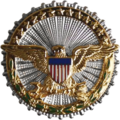George Wikoff | |
|---|---|
 | |
| Born | 1968 (age 56–57) New Brunswick, New Jersey, U.S. [1] |
| Allegiance | United States |
| Branch | United States Navy |
| Service years | 1990–present |
| Rank | Admiral |
| Commands | United States Naval Forces Europe-Africa Allied Joint Force Command Naples United States Naval Forces Central Command United States Fifth Fleet Combined Maritime Forces Naval Air Forces (acting) Naval Air Force, U.S. Pacific Fleet (acting) Carrier Strike Group 5 Carrier Air Wing Three VFA-122 VFA-211 |
| Battles / wars | War in Afghanistan |
| Awards | Defense Superior Service Medal Legion of Merit (4) |
| Alma mater | Catholic University of America |
George M. Wikoff (born 1968) [2] is a United States Navy admiral who serves as the commander of United States Naval Forces Europe-Africa and commander of Allied Joint Force Command Naples since 18 November 2025. He previously served as the commander of the United States Naval Forces Central Command, United States Fifth Fleet, and Combined Maritime Forces from 2024 to 2025. He previously served as the vice director of the Joint Staff from 2021 to 2023. [1] [3] [4] [5]
Contents
In January 2023, Wikoff was nominated for promotion to vice admiral and assignment as commander of the United States Naval Forces Central Command, United States Fifth Fleet, and Combined Maritime Forces. [6] [7] He served as acting commander of Naval Air Forces from 7 September 2023 to January 2024. [8]



